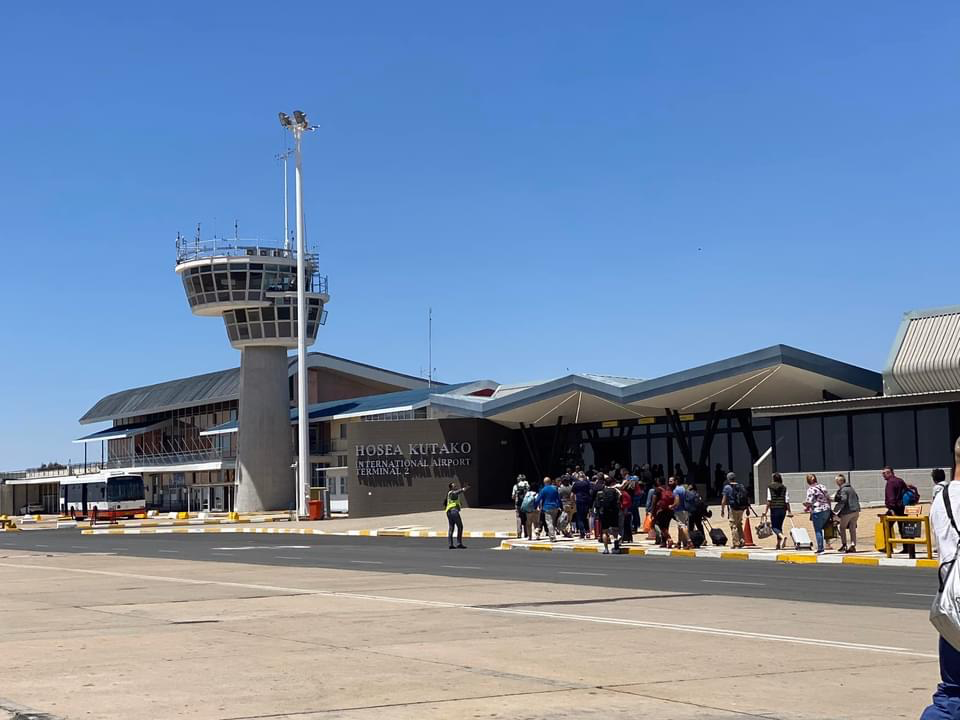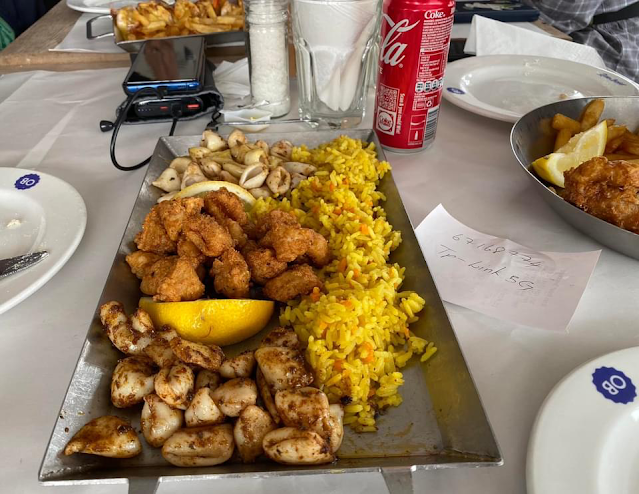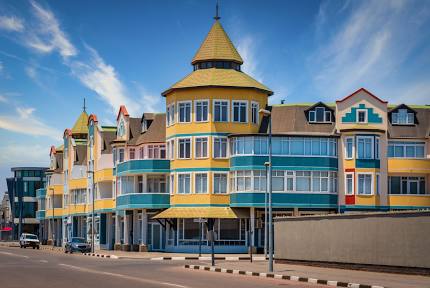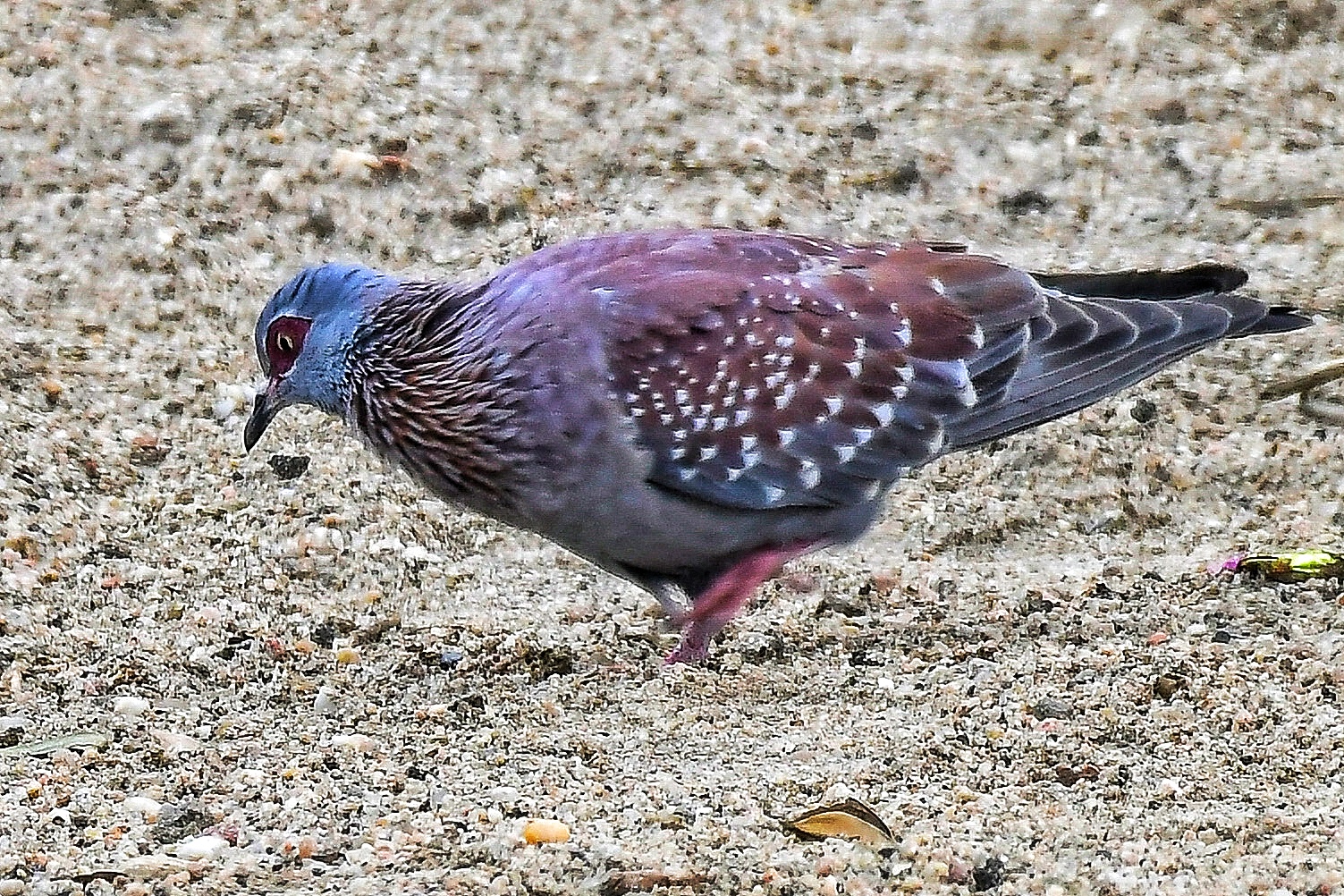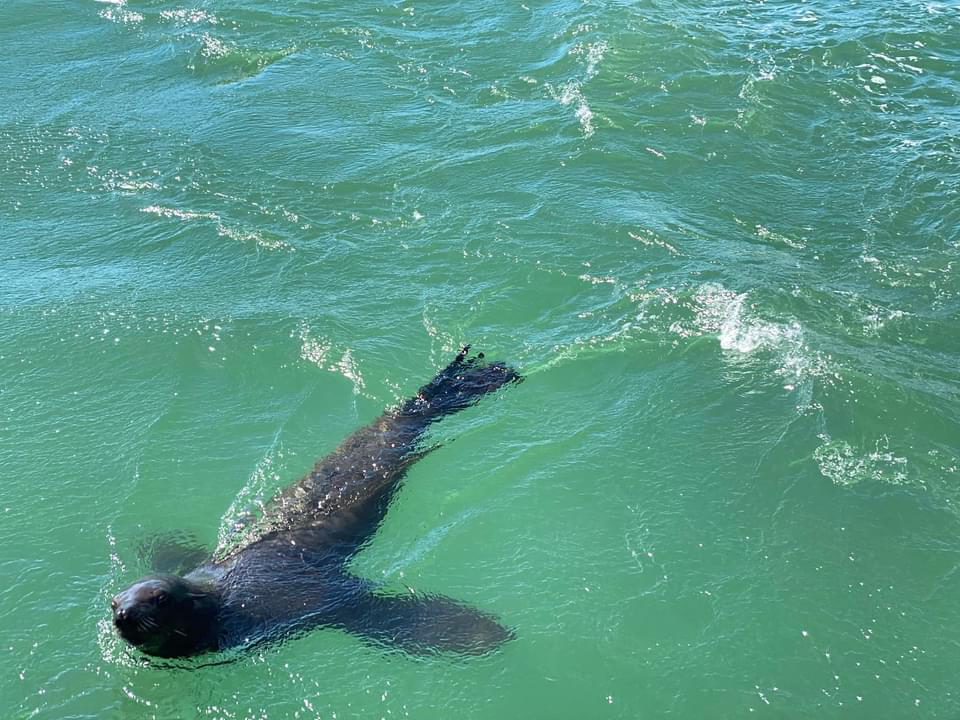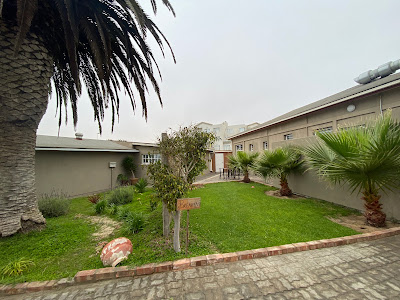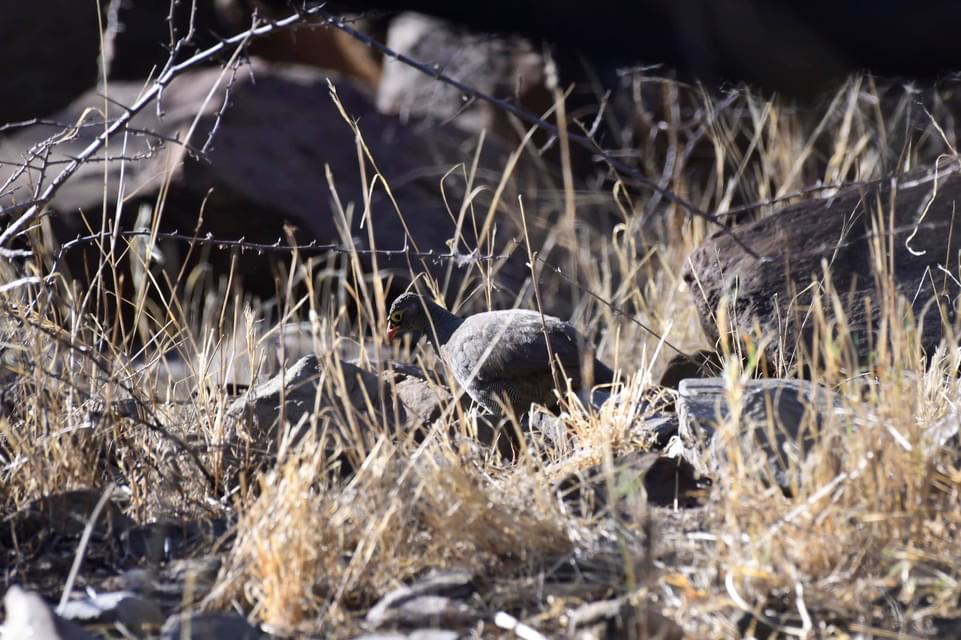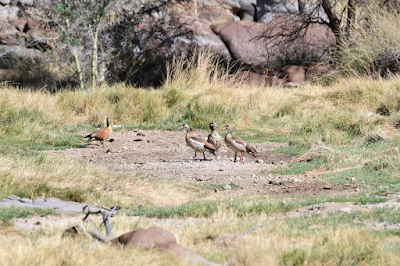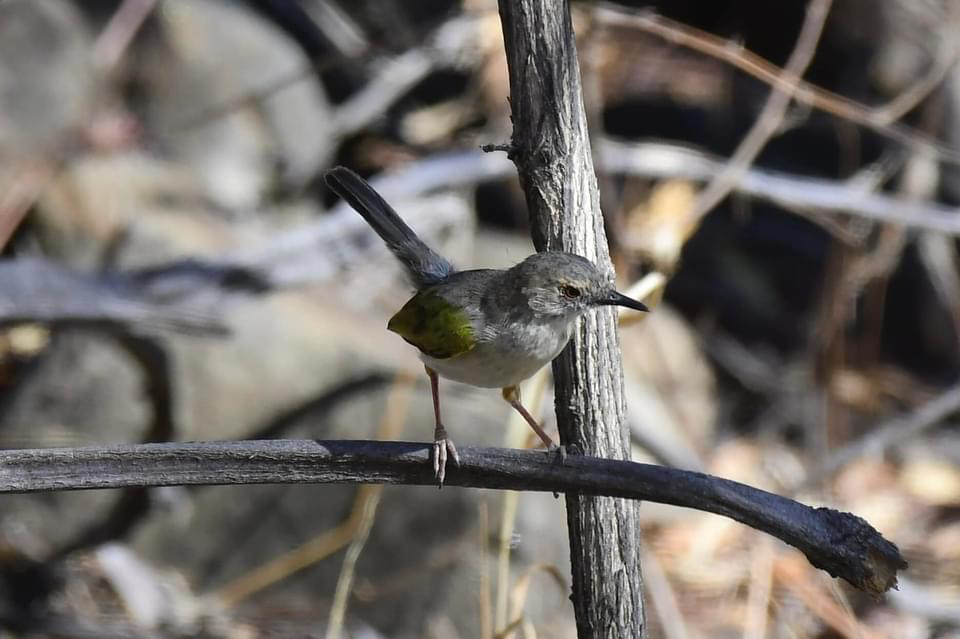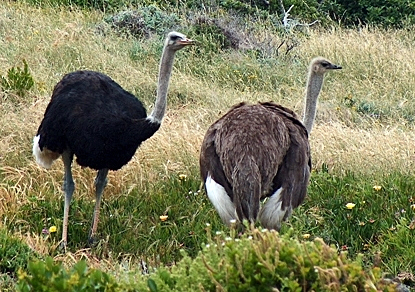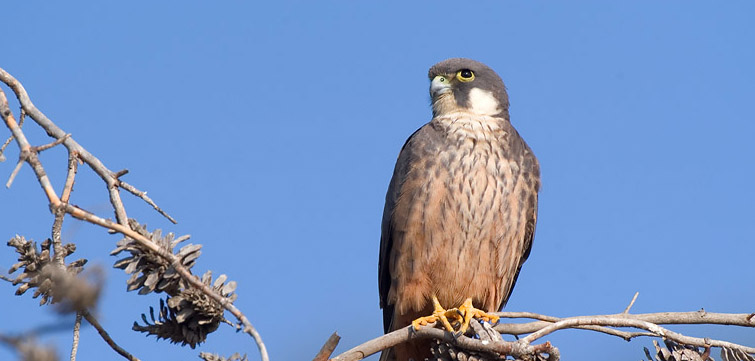 |
| Black-necked Grebe /non breeding |
 |
| South African Shelduck |
1800 check-in Ethithiya Boutique Guest House,
Tuesday morning 17th Oct….
0730 After breakfast, go to Okahandja (75 km. from Windhoek).
Birding
17 Oct 202306:15
Maison Ambre Guesthouse, Khomas, NA
บ้านสวยบนเนินชานเมือง วินดุ๊ก
เช้านี้ทานอาหารเช้าและเชคเอาท์โรงแรม Ethithiya ระหว่างรอหัวหน้าเผ่าที่ต้องแยกไปพักที่อื่นเพราะห้องที่นี่ไม่พอ ก็ไปเดินเล่นดูนกแถวข้างโรงแรมมีนกน่ารักให้ดูพอเพลินๆเจอบ้านเจ้าของใจดีเลี้ยงอาหารนกมีนกหมุนเวียนมากินอาหารกันเซ็งแซ่
Budgerigar นกหงษ์หยก
A small, short-tailed parrot with a soft pink face and dark eyes. Native to southwestern Africa, but feral populations occur in Arizona and in Hawaii; a common pet species, and escapees may occur anywhere. Wild birds are leaf green with brilliant blue rumps, but escaped domestic types may be mostly blue or yellow. Inhabits dry forests and river valleys; present in cities in both natural and introduced range. Call is a shrill, high whistle.
Scarlet-chested SunbirdChalcomitra senegalensis
Dusky SunbirdCinnyris fuscus
A small sunbird. The male is dark overall, with a pale lower belly and orange tufts at the shoulder that are sometimes hidden. The female is plain gray-brown with a paler lower belly. Singles and pairs prefer arid scrub and savanna, feeding on insects and nectar. The species is nomadic and can irrupt in large numbers into areas where it is normally irregular, often on the fringes of its range. The female Dusky Sunbird has paler underparts than the similar female Southern Double-collared Sunbird.
 |
| Female/male nonbreeding |
Red-billed QueleaQuelea quelea
A small, short-tailed weaver with a mottled back and a yellow or reddish bill, eye-ring, and legs. When breeding, the male develops a variable black face mask with a surrounding wash that can be rosy, buff, or cinnamon, although the face can also be whitish. Large flocks are resident and nomadic in arid savanna, grassland, and cultivated areas. In wetter years this species forms enormous flocks numbering tens of thousands, earning it the name “feathered locust.” Non-breeding Red-headed Weaver is superficially similar, but it is much larger than Red-billed Quelea, and it is mostly solitary in woodland and has an unstreaked back.
Gray Go-away-birdCrinifer concolor
White-backed MousebirdColius colius
A mostly grayish, buff-bellied mousebird with a long tail, black-tipped silvery bill, and back with diagnostic white patch flanked by two dark stripes. Small groups inhabit coastal shrublands, farms, and semi-desert; prefers drier areas. A cooperative breeder; chicks from the prior year will remain with parents and help feed and protect the new brood. Sings a melancholic “cheee-wee-wee-wiit”; also produces a distinctive series of buzzes and clicks.
Black-fronted BulbulPycnonotus nigricans
A typical open-country African bulbul with a dark head and a conspicuous and diagnostic fleshy orange-red eye-ring. Pairs and small groups forage in riverine thickets in the Karoo and in arid thorny woodland and scrub, eating a variety of fruit and invertebrates. The species has a typical bubbly musical bulbul song, slower than that of the similar-sounding Common Bulbul. The juvenile Black-fronted Bulbul may be confused with the similar looking Common Bulbul, but it is often accompanied by adults with their diagnostic eye-rings.
 |
| Monteiro’s Hornbill |
Von Bach Dam Nature Reserve is not a renowned game viewing destination, but the area does support common Namibian species. Hartmann’s zebra, red hartebeest, oryx, impala, kudu, giraffe, warthog and small reptiles live there. Birdlife is abundant, in particular around the dam. It’s here where visitors can spot violet wood-hoopoe, black storks, Rüppell’s Parrot and the Bradfield’s Swift. Other species include the grey go-away bird, African jacana, marabou stork, cormorants and the kori bustard.
 แวะทานข้าวเที่ยงที่เขื่อน มีนกให้ดูนิดหน่อย เจอลำธารที่มีน้ำไหลสายแรกและสายเดียวของทริป มีแมลงปอบ้านๆ 3 ชนิด มีเป็ด มีไก่ รวมอยู่ด้วยกัน
แวะทานข้าวเที่ยงที่เขื่อน มีนกให้ดูนิดหน่อย เจอลำธารที่มีน้ำไหลสายแรกและสายเดียวของทริป มีแมลงปอบ้านๆ 3 ชนิด มีเป็ด มีไก่ รวมอยู่ด้วยกันInspector
Chalcostephia flavifronsChalcostephia flavifrons is a fairly small species of dragonfly, with a hind-wing length of 24 to 29 mm (0.9 to 1.1 in). The mature adult male is a bluish-grey colour and pruinose (covered with a dusting of wax particles on top of the cuticle). The adult female and the newly emerged male are dark with bold yellow banding. Both males and females can be distinguished from other similar species by their yellow face contrasting with the flattened, metallic green frons (front of the head).
The membranous, veined wings are transparent except for the pterostigmata, a small group of thickened cells at the leading edge of the wing-tips, which have pale centres and dark edges.
Dragonflies are fascinating insects, true jewels of the watershed. Their diversity in Namibia is surprisingly high for such an arid country. Dragonflies and Damselflies of Namibia describes 127 species and their distribution range, habitat, ecology and behaviour, while the identification keys cover not only the Namibian species, but also those of neighbouring Botswana and southern Angola, 149 species in all. The general overview of dragonfly biology and the species descriptions are extensively illustrated with 174 photographs, 27 plates with line drawings and 125 distribution maps. Frank Suhling is an associate professor of ecology at the Technical University of Braunschweig, Germany. His main research interest is dragonfly larvae and communities. Andreas Martens is a professor of biology at Karlsruhe University of Education, Germany. His main research interest is the reproductive behaviour of dragonflies. Both authors have studied dragonflies for well over 20 years. Between 2000 and 2007 their research on Namibian Odonata formed part of the BIOTA AFRICA programme.
17 Oct 202313:12
Von Bach Dam Nature Reserve, Otjozondjupa, NA
Red-billed SpurfowlPternistis adspersus
A medium-sized, brown francolin that is finely barred on the belly, head, and back. It has a diagnostic broad yellow eyering and reddish bill and feet. The juvenile has a reduced eyering and diffuse barring. The harsh, crowing, territorial call given from a low perch (“chak, chak, chak, CHAK, chakitty, chakitty”) is gruffer and lower-pitched than those of other francolins in its range. Natal Francolin differs by having scaled (not barred) underparts and lacking an eyering. Swainson’s Francolin differs by lacking barring and having red facial skin and dark blackish legs.
Red-crested BustardLophotis ruficrista
A medium-sized, black-bellied bustard with diagnostic white chevrons on a brown-and-black mottled back. The male has a brown-gray neck and slaty cap, and the female is plainer. The name is misleading, as the red crest is almost always hidden. It walks slowly and steadily in arid woodlands, where it is common but due to its camouflage often avoids detection. The song is a sequence of clicking “tic-tic” notes that are followed by a mournful piping “sweee-swee-sweee sweet” series that accelerates to a crescendo. The male indulges in an absurd display in which he flies nearly vertically into the sky and then folds his wings and somersaults down as if shot, only to unbelievably land on his feet. In flight the Red-crested Bustard’s all-black underwings differentiate it from Black-bellied Bustard, which has white windows in the underwing.
African JacanaActophilornis africanus
A distinctive chestnut, white, and black waterbird with a sky-blue bill and enormous feet. The immature lacks the blue bill and shield and is brown-headed. Resident and nomadic, this species trots on the surface of water lilies and other aquatic vegetation, using its long legs and ludicrously elongated toes to prevent it from sinking. It flies weakly, low over the water, with legs and toes dangling behind awkwardly, and calls with a honking repeated “kyaaan” and wheezy hurried “skreeeeeet’--most often in flight. Highly unusual mating system in which one dominant female maintains a harem of multiple males. After egg-laying, each male will raise a brood alone.
 Egyptian GooseAlopochen aegyptiaca
Egyptian GooseAlopochen aegyptiaca
This striking “goose” (in actuality more closely related to shelducks) is native to Africa, mainly the eastern and southern parts of the continent; it has also been introduced widely across Europe and parts of the U.S. Distinctive: note the staring pale eye surrounded by a dark patch, pink legs, and overall gray and buffy plumage. In flight, look for bright white forewings. Usually found in pairs or family groups. Feeds while swimming and by grazing on shore.
White-tailed ShrikeLanioturdus torquatus
Odd and distinctive terrestrial batis. Has long legs, an upright posture, and a white tail with a black dot near the tip. Found in dry woodland and savanna, often in rocky areas. Spends most of its time on or near the ground, though it will perch up in bushes. Usually in pairs. Vocalizations include piercing whistles, low croaks, and ratcheting calls. Similar to batises, but terrestrial habits and white tail easily identify it.
Chestnut-vented WarblerCurruca subcoerulea
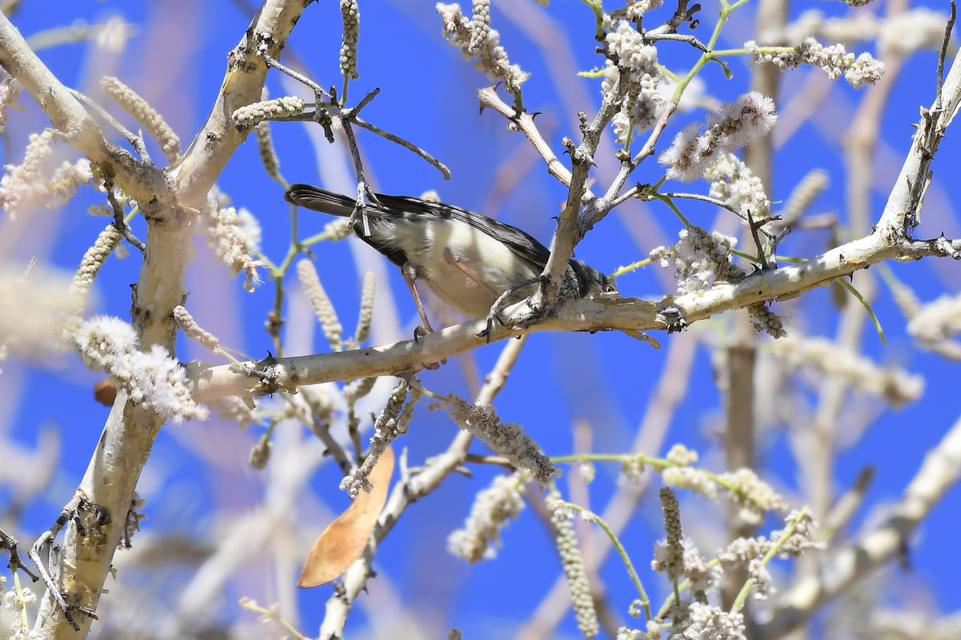 Distinctive gray bird with a pale eye, streaked throat, rufous vent, and large white patches on the tail. Found in a variety of habitats with thick shrubs, including fynbos, karoo, semi-desert, and savanna. A fairly skulking species that is usually detected by voice: an exuberant mixture of ratcheting notes, chatters, and whistles. Similar to Layard’s Warbler, but easily distinguished by rufous vent and more heavily streaked throat.
Distinctive gray bird with a pale eye, streaked throat, rufous vent, and large white patches on the tail. Found in a variety of habitats with thick shrubs, including fynbos, karoo, semi-desert, and savanna. A fairly skulking species that is usually detected by voice: an exuberant mixture of ratcheting notes, chatters, and whistles. Similar to Layard’s Warbler, but easily distinguished by rufous vent and more heavily streaked throat.
 Distinctive gray bird with a pale eye, streaked throat, rufous vent, and large white patches on the tail. Found in a variety of habitats with thick shrubs, including fynbos, karoo, semi-desert, and savanna. A fairly skulking species that is usually detected by voice: an exuberant mixture of ratcheting notes, chatters, and whistles. Similar to Layard’s Warbler, but easily distinguished by rufous vent and more heavily streaked throat.
Distinctive gray bird with a pale eye, streaked throat, rufous vent, and large white patches on the tail. Found in a variety of habitats with thick shrubs, including fynbos, karoo, semi-desert, and savanna. A fairly skulking species that is usually detected by voice: an exuberant mixture of ratcheting notes, chatters, and whistles. Similar to Layard’s Warbler, but easily distinguished by rufous vent and more heavily streaked throat.Marico SunbirdCinnyris mariquensis
Male is iridescent green above with a dark belly and maroon and bluish bands across the breast. Female is nondescript, with blurry streaks across the pale yellow underparts. Found in woodland, scrub, and savanna, including semi-desert thornscrub. Most distinctive vocalization is an energetic series of “tyip” notes. Also gives a high-pitched, jumbled song. Very similar to several other sunbird species but distinguished by slightly larger size and longer bill with a thicker base.
Green-backed CamaropteraCamaroptera brachyura
A small, rotund, wren-like warbler of the understory that often leans forward and cocks its short narrow tail. This species has red eyes, olive-green wings, and gray-white underparts. There are two groups that are sometimes treated as different species: (1) “green-backed” birds along the eastern seaboard of Africa from southeast Kenya to coastal South Africa; and (2) “gray-backed” birds in the remainder of Africa. Pairs inhabit thickets and riverine woodland in arid and moist savanna, forest, and forest edge, hopping about, often low to the ground, searching for small insects. Their two common vocalizations are a nasal “meehrrp” alarm call that gives them the moniker “bleating warbler” and a strident, repeated snapping “strik-strik-strik-strik-strik” song.
The common agama, red-headed rock agama or rainbow agama (Agama agama) is a species of lizard from the family Agamidae found in most of sub-Saharan Africa. To clear up historical confusion based on Linnaeus and other authors, Wagner, et al. (2009) [2]designated a neotype (ZFMK 15222) for the species, using a previously described specimen from Cameroon in the collection of the Zoologisches Forschungsmuseum Alexander Koenig in Bonn. The species name was formerly applied to a paraphyleticcollection of taxa, and mitochondrial DNA analysis of various populations indicates they represent separate species.[3],[4] Consequently, three former subspecies A. a. africana, A. a. boensis, and A. a. mucosoensis are now considered separate species, and A. a. savattieriis considered synonymous with A. africana.[5]
To be continued
·
·
Appendix List of birds of Namibia
Order: Struthioniformes
Common name: Ostriches Family: Struthionidae
Ostriches are flightless birds native to Africa. They are the largest living species of bird. They are distinctive in appearance, with a long neck and legs and the ability to run at high speeds.
- Common ostrich, Struthio camelus
- South African ostrich, S. c. australis
Order: Anseriformes

Common name: Ducks, geese, and waterfowl Family: Anatidae
Anatidae includes the ducks and most duck-like waterfowl, such as geese and swans. These birds are adapted to an aquatic existence with webbed feet, flattened bills, and feathers that are excellent at shedding water due to an oily coating.
- White-faced whistling-duck, Dendrocygna viduata
- Fulvous whistling-duck, Dendrocygna bicolor
- White-backed duck, Thalassornis leuconotus
- Knob-billed duck, Sarkidiornis melanotos
- Egyptian goose, Alopochen aegyptiacus
- South African shelduck, Tadorna cana
- Spur-winged goose, Plectropterus gambensis
- African pygmy-goose, Nettapus auritus
- Garganey, Spatula querquedula (V)
Garganey - Blue-billed teal, Spatula hottentota
- Cape shoveler, Spatula smithii
 |
| A pair Northern shoveler foraging together |
- Northern shoveler, Spatula clypeata (V)
- African black duck, Anas sparsa
- Yellow-billed duck, Anas undulata
- Mallard, Anas platyrhynchos (I)
- Cape teal, Anas capensis
- Red-billed duck, Anas erythrorhyncha
- Southern pochard, Netta erythrophthalma
- Maccoa duck, Oxyura maccoa
Order: Galliformes
Guineafowl

Family: Numididae
Guineafowl are a group of African, seed-eating, ground-nesting birds that resemble partridges, but with featherless heads and spangled grey plumage.
 |
| Western crested guineafowl |
- Helmeted guineafowl, Numida meleagris
- Western crested guineafowl, Guttera verreauxi
Pheasants, grouse, and allies

Family: Phasianidae
The Phasianidae are a family of terrestrial birds which consists of quails, partridges, snowcocks, francolins, spurfowls, tragopans, monals, pheasants, peafowls, and jungle fowls. In general, they are plump (although they vary in size) and have broad, relatively short wings.
- Crested francolin, Ortygornis sephaena
- Coqui francolin, Campocolinus coqui
- Orange River francolin, Scleroptila gutturalis
- Common quail, Coturnix coturnix
- Harlequin quail, Coturnix delegorguei
- Hartlaub's francolin, Pternistis hartlaubi
- Red-billed francolin, Pternistis adspersus
- Cape francolin, Pternistis capensis
- Swainson's francolin, Pternistis swainsonii
- Red-necked francolin, Pternistis afer
Order: Phoenicopteriformes
Common name: Flamingos Family: Phoenicopteridae

- Greater flamingo, Phoenicopterus ros
- Lesser flamingo, Phoeniconaias minor
Order: Podicipediformes
Common name: Grebes Family: Podicipedidae
Grebes are small to medium-large freshwater diving birds. They have lobed toes and are excellent swimmers and divers. However, they have their feet placed far back on the body, making them quite ungainly on land.
- Little grebe, Tachybaptus ruficollis
- Great crested grebe, Podiceps cristatus
- Eared grebe, Podiceps nigricollis
Order: Columbiformes
Common name: Pigeons and doves Family: Columbidae
Pigeons and doves are stout-bodied birds with short necks and short slender bills with a fleshy cere.
- Rock pigeon, Columba livia (I)
Rock pigeon - Speckled pigeon, Columba guinea
- European turtle-dove, Streptopelia turtur (V)
- Mourning collared-dove, Streptopelia decipiens
- Red-eyed dove, Streptopelia semitorquata
- Ring-necked dove, Streptopelia capicola
- Laughing dove, Streptopelia senegalensis
- Emerald-spotted wood-dove, Turtur chalcospilos
- Namaqua dove, Oena capensis
- African green-pigeon, Treron calva
Order: Pterocliformes
Common name: Sandgrouse Family: Pteroclidae
Sandgrouse have small, pigeon-like heads and necks, but sturdy compact bodies. They have long pointed wings and sometimes tails and a fast direct flight. Flocks fly to watering holes at dawn and dusk. Their legs are feathered down to the toes.
- Namaqua sandgrouse, Pterocles namaqua
Double-banded - Yellow-throated sandgrouse, Pterocles gutturalis
- Double-banded sandgrouse, Pterocles bicinctus
- Burchell's sandgrouse, Pterocles burchelli
Order: Otidiformes

Common name: Bustards Family: Otididae
Bustards are large terrestrial birds mainly associated with dry open country and steppes in the Old World. They are omnivorous and nest on the ground. They walk steadily on strong legs and big toes, pecking for food as they go. They have long broad wings with "fingered" wingtips and striking patterns in flight. Many have interesting mating displays.
- Kori bustard, Ardeotis kori
- Ludwig's bustard, Neotis ludwigii
- Denham's bustard, Neotis denhami (V)
Karoo bustard - White-bellied bustard, Eupodotis senegalensis (V)
- Karoo bustard, Eupodotis vigorsii
- Rüppell's bustard, Eupodotis rueppellii
- Red-crested bustard, Eupodotis ruficrista
- White-quilled bustard, Eupodotis afroides
- Black-bellied bustard, Lissotis melanogaster
Order: Musophagiformes
Common name: Turacos Family: Musophagidae
The turacos, plantain eaters, and go-away-birds make up the bird family Musophagidae. They are medium-sized arboreal birds. The turacos and plantain eaters are brightly coloured, usually in blue, green, or purple. The go-away birds are mostly grey and white.
 |
| Ross's turaco, |
- Schalow's turaco, Tauraco schalowi
- Ross's turaco, Musophaga rossae (V)
- Gray go-away-bird, Corythaixoides concolor
Order: Cuculiformes
Common name: cuckoos, coucals, roadrunners and anis Family: Cuculidae
The family Cuculidae includes cuckoos, roadrunners, and anis. These birds are of variable size with slender bodies, long tails, and strong legs. Most of the cuckoo species of the Old World are brood parasites.
- Senegal coucal, Centropus senegalensis
Senegal coucal - Coppery-tailed coucal, Centropus cupreicaudus
- White-browed coucal, Centropus superciliosus
- Black coucal, Centropus grillii
- Great spotted cuckoo, Clamator glandarius
- Levaillant's cuckoo, Clamator levaillantii
- Pied cuckoo, Clamator jacobinus
- Thick-billed cuckoo, Pachycoccyx audeberti
- Dideric cuckoo, Chrysococcyx caprius
- Klaas's cuckoo, Chrysococcyx klaas
- African emerald cuckoo, Chrysococcyx cupreus
African emerald cuckoo, - Black cuckoo, Cuculus clamosus
- Red-chested cuckoo, Cuculus solitarius
- African cuckoo, Cuculus gularis
- Common cuckoo, Cuculus canorus
Order: Caprimulgiformes
Nightjars and allies
Family: Caprimulgidae
Nightjars are medium-sized nocturnal birds that usually nest on the ground. They have long wings, short legs, and very short bills. Most have small feet, of little use for walking, and long pointed wings. Their soft plumage is camouflaged to resemble bark or leaves.
 |
| Square-tailed nightjar |
- Pennant-winged nightjar, Caprimulgus vexillarius
- Eurasian nightjar, Caprimulgus europaeus
- Rufous-cheeked nightjar, Caprimulgus rufigena
- Fiery-necked nightjar, Caprimulgus pectoralis
- Swamp nightjar, Caprimulgus natalensis
- Freckled nightjar, Caprimulgus tristigma
- Square-tailed nightjar, Caprimulgus fossii
Order: Apodiformes
Swifts
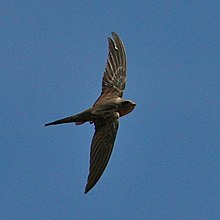
Family: Apodidae
Swifts are small birds which spend the majority of their lives flying. These birds have very short legs and never settle voluntarily on the ground, perching instead only on vertical surfaces. Many swifts have long swept-back wings which resemble a crescent or boomerang.
- Bat-like spinetail, Neafrapus boehmi
- Alpine swift, Apus melba
- Common swift, Apus apus
- African swift, Apus barbatus
- Bradfield's swift, Apus bradfieldi
- Little swift, Apus affinis
- Horus swift, Apus horus
- White-rumped swift, Apus caffer
- African palm-swift, Cypsiurus parvus
Order: Gruiformes
Flufftails
Family: Sarothruridae
The flufftails are a small family of ground-dwelling birds found only in Madagascar and sub-Saharan Africa.
 |
| Red-chested flufftail |
- Buff-spotted flufftail, Sarothrura elegans
- Red-chested flufftail, Sarothrura rufa
Rails, gallinules, and coots
Family: Rallidae
Rallidae is a large family of small to medium-sized birds which includes the rails, crakes, coots, and gallinules. Typically they inhabit dense vegetation in damp environments near lakes, swamps, or rivers. In general they are shy and secretive birds, making them difficult to observe. Most species have strong legs and long toes which are well adapted to soft uneven surfaces. They tend to have short, rounded wings and to be weak fliers.
- African rail, Rallus caerulescens
African crake, - Corn crake, Crex crex (V)
- African crake, Crex egregia
- Spotted crake, Porzana porzana
- Lesser moorhen, Paragallinula angulata
- Eurasian moorhen, Gallinula chloropus
Common moorhen - Red-knobbed coot, Fulica cristata
- Allen's gallinule, Porphyrio alleni
- Purple gallinule, Porphyrio martinica (V)
Purple gallinule - African swamphen, Porphyrio madagascariensis
- Striped crake, Amaurornis marginalis
- Black crake, Zapornia flavirostra
- Baillon's crake, Zapornia pusilla
Finfoots
Family: Heliornithidae

- African finfoot, Podica senegalensis
Cranes

Family: Gruidae
Cranes are large, long-legged, and long-necked birds. Unlike the similar-looking but unrelated herons, cranes fly with necks outstretched, not pulled back. Most have elaborate and noisy courting displays or "dances".
- Gray crowned-crane, Balearica regulorum
- Blue crane, Anthropoides paradisea
- Wattled crane, Bugeranus carunculatus
Order: Charadriiformes
Thick-knees
Family: Burhinidae
The thick-knees are a group of waders found worldwide within the tropical zone, with some species also breeding in temperate Europe and Australia. They are medium to large waders with strong black or yellow-black bills, large yellow eyes, and cryptic plumage. Despite being classed as waders, most species have a preference for arid or semi-arid habitats.
- Water thick-knee, Burhinus vermiculatus
- Spotted thick-knee, Burhinus capensis
Stilts and avocets

Family: Recurvirostridae
Recurvirostridae is a family of large wading birds which includes the avocets and stilts. The avocets have long legs and long up-curved bills. The stilts have extremely long legs and long, thin, straight bills.
- Black-winged stilt, Himantopus himantopus
- Pied avocet, Recurvirostra avosetta
Oystercatchers
Family: Haematopodidae
The oystercatchers are large and noisy plover-like birds, with strong bills used for smashing or prising open molluscs.
- Eurasian oystercatcher, Haematopus ostralegus
- African oystercatcher, Haematopus moquini
Plovers and lapwings

Family: Charadriidae
The family Charadriidae includes the plovers, dotterels, and lapwings. They are small to medium-sized birds with compact bodies, short thick necks, and long, usually pointed, wings. They are found in open country worldwide, mostly in habitats near water.
- Black-bellied plover, Pluvialis squatarola
- American golden-plover, Pluvialis dominica (V)
- Pacific golden-plover, Pluvialis fulva (V)
- Long-toed lapwing, Vanellus crassirostris
- Blacksmith lapwing, Vanellus armatus
- Spur-winged lapwing, Vanellus spinosus (V)
- White-headed lapwing, Vanellus albiceps
- Crowned lapwing, Vanellus coronatus
- Wattled lapwing, Vanellus senegallus
- Lesser sand-plover, Charadrius mongolus (V)
- Greater sand-plover, Charadrius leschenaultii (V)
- Caspian plover, Charadrius asiaticus
- Kittlitz's plover, Charadrius pecuarius
- Kentish plover, Charadrius alexandrinus
- Common ringed plover, Charadrius hiaticula
- Three-banded plover, Charadrius tricollaris
- White-fronted plover, Charadrius marginatus
- Chestnut-banded plover, Charadrius pallidus
Painted-snipes
Family: Rostratulidae
Painted-snipes are short-legged, long-billed birds similar in shape to the true snipes, but more brightly coloured.
- Greater painted-snipe, Rostratula benghalensis
Jacanas
Family: Jacanidae
The jacanas are a group of waders found throughout the tropics. They are identifiable by their huge feet and claws which enable them to walk on floating vegetation in the shallow lakes that are their preferred habitat.
- Lesser jacana, Microparra capensis
- African jacana, Actophilornis africanus
Sandpipers and allies

Family: Scolopacidae
Scolopacidae is a large diverse family of small to medium-sized shorebirds including the sandpipers, curlews, godwits, shanks, tattlers, woodcocks, snipes, dowitchers, and phalaropes. The majority of these species eat small invertebrates picked out of the mud or soil. Variation in length of legs and bills enables multiple species to feed in the same habitat, particularly on the coast, without direct competition for food.
- Whimbrel, Numenius phaeopus
- Eurasian curlew, Numenius arquata (V)
- Bar-tailed godwit, Limosa lapponica
- Black-tailed godwit, Limosa limosa (V)
- Ruddy turnstone, Arenaria interpres
- Great knot, Calidris tenuirostris (V)
- Red knot, Calidris canutus
- Ruff, Calidris pugnax
- Broad-billed sandpiper, Calidris falcinellus (V)
- Curlew sandpiper, Calidris ferruginea
- Sanderling, Calidris alba
- Baird's sandpiper, Calidris bairdii (V)
- Little stint, Calidris minuta
- White-rumped sandpiper, Calidris fuscicollis (V)
- Buff-breasted sandpiper, Calidris subruficollis (V)
- Pectoral sandpiper, Calidris melanotos (V)
- Great snipe, Gallinago media
- African snipe, Gallinago nigripennis
- Terek sandpiper, Xenus cinereus
- Wilson's phalarope, Phalaropus tricolor (V)
- Red-necked phalarope, Phalaropus lobatus
- Red phalarope, Phalaropus fulicarius
- Common sandpiper, Actitis hypoleucos
- Green sandpiper, Tringa ochropus
- Common greenshank, Tringa nebularia
- Lesser yellowlegs, Tringa flavipes (V)
- Marsh sandpiper, Tringa stagnatilis
- Wood sandpiper, Tringa glareola
- Common redshank, Tringa totanus
Buttonquail
Family: Turnicidae
The buttonquail are small, drab, running birds which resemble the true quails. The female is the brighter of the sexes and initiates courtship. The male incubates the eggs and tends the young.
- Small buttonquail, Turnix sylvaticus
Pratincoles and coursers
Family: Glareolidae
Glareolidae is a family of wading birds comprising the pratincoles, which have short legs, long pointed wings, and long forked tails, and the coursers, which have long legs, short wings, and long, pointed bills which curve downwards.
- Burchell's courser, Cursorius rufus
- Temminck's courser, Cursorius temminckii
- Double-banded courser, Smutsornis africanus
- Three-banded courser, Rhinoptilus cinctus
- Bronze-winged courser, Rhinoptilus chalcopterus
- Collared pratincole, Glareola pratincola
- Black-winged pratincole, Glareola nordmanni
- Rock pratincole, Glareola nuchalis
Skuas and jaegers
Family: Stercorariidae
The family Stercorariidae are, in general, medium to large birds, typically with grey or brown plumage, often with white markings on the wings. They nest on the ground in temperate and arctic regions and are long-distance migrants.
- Brown skua, Stercorarius antarctica
- Pomarine jaeger, Stercorarius pomarinus
- Parasitic jaeger, Stercorarius parasiticus
- Long-tailed jaeger, Stercorarius longicaudus (V)
Gulls, terns, and skimmers

Family: Laridae
Laridae is a family of medium to large seabirds, the gulls, terns, and skimmers. Gulls are typically grey or white, often with black markings on the head or wings. They have stout, longish bills and webbed feet. Terns are a group of generally medium to large seabirds typically with grey or white plumage, often with black markings on the head. Most terns hunt fish by diving but some pick insects off the surface of fresh water. Terns are generally long-lived birds, with several species known to live in excess of 30 years. Skimmers are a small family of tropical tern-like birds. They have an elongated lower mandible which they use to feed by flying low over the water surface and skimming the water for small fish.
- Sabine's gull, Xema sabini
- Gray-hooded gull, Chroicocephalus cirrocephalus
- Hartlaub's gull, Chroicocephalus hartlaubii
- Black-headed gull, Chroicocephalus ridibundus (V)
- Franklin's gull, Leucophaeus pipixcan (V)
- Yellow-legged gull, Larus michahellis (V)
- Lesser black-backed gull, Larus fuscus (V)
- Kelp gull, Larus dominicanus
- Sooty tern, Onychoprion fuscatus (V)
- Little tern, Sternula albifrons (V)
- Damara tern, Sternula balaenarum
- Gull-billed tern, Gelochelidon nilotica (V)
- Caspian tern, Hydroprogne caspia
- Black tern, Chlidonias niger
- White-winged tern, Chlidonias leucopterus
- Whiskered tern, Chlidonias hybrida
- Common tern, Sterna hirundo
- Arctic tern, Sterna paradisaea
- Antarctic tern, Sterna vittata (V)
- Great crested tern, Thalasseus bergii
- Sandwich tern, Thalasseus sandvicensis
- Elegant tern, Thalasseus elegans (V)
- West African crested tern, Thalasseus albididorsalis (V)
- Black skimmer, Rynchops niger (V)
- African skimmer, Rynchops flavirostris
Order: Phaethontiformes
Common name: Tropicbirds Family: Phaethontidae
Tropicbirds are slender white birds of tropical oceans with exceptionally long central tail feathers. Their heads and long wings have black markings.
- White-tailed tropicbird, Phaethon lepturus (V)
- Red-billed tropicbird, Phaethon aethereus (V)
Order: Sphenisciformes

Common name: Penguins Family: Spheniscidae
The penguins are a group of aquatic, flightless birds living almost exclusively in the Southern Hemisphere. Most penguins feed on krill, fish, squid, and other forms of sealife caught while swimming underwater.
- Little penguin, Eudyptula minor (V)
- African penguin, Spheniscus demersus
Order: Procellariformes
Albatrosses
Family: Diomedeidae
The albatrosses are among the largest of flying birds, and the great albatrosses from the genus Diomedea have the largest wingspans of any extant birds.
- Yellow-nosed albatross, Thalassarche chlororhynchos
- Gray-headed albatross, Thalassarche chrysostoma (V)
- White-capped albatross, Thalassarche cauta
- Black-browed albatross, Thalassarche melanophris
- Wandering albatross, Diomedea exulans
Southern storm-petrels

Family: Oceanitidae
The storm-petrels are the smallest seabirds, relatives of the petrels, feeding on planktonic crustaceans and small fish picked from the surface, typically while hovering. The flight is fluttering and sometimes bat-like. Until 2018, this family's species were included with the other storm-petrels in family Hydrobatidae.
- Wilson's storm-petrel, Oceanites oceanicus
- White-bellied storm-petrel, Fregetta grallaria (V)
- Black-bellied storm-petrel, Fregetta tropica
Northern storm-petrels
Family: Hydrobatidae
Though the members of this family are similar in many respects to the southern storm-petrels, including their general appearance and habits, there are enough genetic differences to warrant their placement in a separate family.
- European storm-petrel, Hydrobates pelagicus
- Leach's storm-petrel, Hydrobates leucorhous
- Band-rumped storm-petrel, Hydrobates castro (V)
Shearwaters and petrels
Family: Procellariidae
The procellariids are the main group of medium-sized "true petrels", characterised by united nostrils with medium septum and a long outer functional primary.
- Southern giant-petrel, Macronectes giganteus
- Northern giant-petrel, Macronectes halli
- Southern fulmar, Fulmarus glacialoides (V)
- Cape petrel, Daption capense
- Great-winged petrel, Pterodroma macroptera
- Soft-plumaged petrel, Pterodroma mollis
- Barau's petrel, Pterodroma baraui (V)
- Atlantic petrel, Pterodroma incerta (V)
- Fairy prion, Pachyptila turtur
- Antarctic prion, Pachyptila desolata
- Bulwer's petrel, Bulweria bulwerii (V)
- White-chinned petrel, Procellaria aequinoctialis
- Spectacled petrel, Procellaria conspicillata
- Cory's shearwater, Calonectris borealis
- Great shearwater, Ardenna gravis
- Sooty shearwater, Ardenna griseus
- Manx shearwater, Puffinus puffinus
- Tropical shearwater, Puffinus bailloni (V)
Order: Ciconiiformes
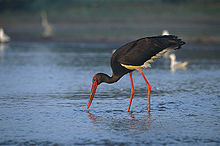
Common name: Storks Family: Ciconiidae
Storks are large, long-legged, long-necked, wading birds with long, stout bills. Storks are mute, but bill-clattering is an important mode of communication at the nest. Their nests can be large and may be reused for many years. Many species are migratory.
- African openbill, Anastomus lamelligerus
- Black stork, Ciconia nigra
- Abdim's stork, Ciconia abdimii
- African woolly-necked stork, Ciconia microscelis
- White stork, Ciconia ciconia
- Saddle-billed stork, Ephippiorhynchus senegalensis
- Marabou stork, Leptoptilos crumenifer
- Yellow-billed stork, Mycteria ibis
Order: Suliformes
Boobies and gannets

Family: Sulidae
The sulids comprise the gannets and boobies. Both groups are medium to large coastal seabirds that plunge-dive for fish.
- Brown booby, Sula leucogaster (V)
- Red-footed booby, Sula sula (V)
- Cape gannet, Morus capensis
- Australasian gannet, Morus serrator (V)
Anhingas
Family: Anhingidae
Anhingas or darters are often called "snake-birds" because of their long thin neck, which gives a snake-like appearance when they swim with their bodies submerged. The males have black and dark-brown plumage, an erectile crest on the nape and a larger bill than the female. The females have much paler plumage especially on the neck and underparts. The darters have completely webbed feet and their legs are short and set far back on the body. Their plumage is somewhat permeable, like that of cormorants, and they spread their wings to dry after diving.
- African darter, Anhinga rufa
Cormorants and shags
Family: Phalacrocoracidae
Phalacrocoracidae is a family of medium to large coastal, fish-eating seabirds that includes cormorants and shags. Plumage colouration varies, with the majority having mainly dark plumage, some species being black-and-white, and a few being colourful.
- Long-tailed cormorant, Microcarbo africanus
- Crowned cormorant, Microcarbo coronatus
- Bank cormorant, Phalacrocorax neglectus
- Cape cormorant, Phalacrocorax capensis
- Great cormorant, Phalacrocorax carbo
Order: Pelecaniformes
Pelicans
Family: Pelecanidae
Pelicans are large water birds with a distinctive pouch under their beak. They have webbed feet with four toes.
- Great white pelican, Pelecanus onocrotalus
- Pink-backed pelican, Pelecanus rufescens
Hamerkop
Family: Scopidae
The hamerkop is a medium-sized bird with a long shaggy crest. The shape of its head with a curved bill and crest at the back is reminiscent of a hammer, hence its name. Its plumage is drab-brown all over.
- Hamerkop, Scopus umbretta
Herons, egrets, and bitterns
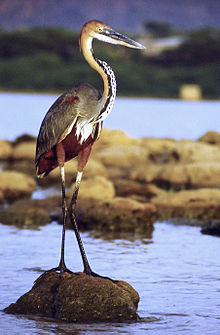
Family: Ardeidae
The family Ardeidae contains the bitterns, herons, and egrets. Herons and egrets are medium to large wading birds with long necks and legs. Bitterns tend to be shorter necked and more wary. Members of Ardeidae fly with their necks retracted, unlike other long-necked birds such as storks, ibises, and spoonbills.
- Great bittern, Botaurus stellaris
- Little bittern, Ixobrychus minutus
- Dwarf bittern, Ixobrychus sturmii
- Gray heron, Ardea cinerea
- Black-headed heron, Ardea melanocephala
- Goliath heron, Ardea goliath
- Purple heron, Ardea purpurea
- Great egret, Ardea alba
- Intermediate egret, Ardea intermedia
- Little egret, Egretta garzetta
- Slaty egret, Egretta vinaceigula
- Black heron, Egretta ardesiaca
- Cattle egret, Bubulcus ibis
- Squacco heron, Ardeola ralloides
- Rufous-bellied heron, Ardeola rufiventris
- Striated heron, Butorides striata
- Black-crowned night-heron, Nycticorax nycticorax
- White-backed night-heron, Gorsachius leuconotus
Ibises and spoonbills
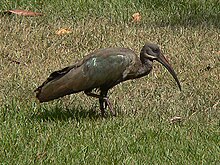
Family: Threskiornithidae
Threskiornithidae is a family of large terrestrial and wading birds which includes the ibises and spoonbills. They have long, broad wings with 11 primary and about 20 secondary feathers. They are strong fliers and despite their size and weight, very capable soarers.
- Glossy ibis, Plegadis falcinellus
- African sacred ibis, Threskiornis aethiopicus
- Hadada ibis, Bostrychia hagedash
- African spoonbill, Platalea alba
Order: Accipitriformes
Secretarybird
Family: Sagittariidae
The secretarybird is a bird of prey which is easily distinguished from other raptors by its long crane-like legs.
- Secretarybird, Sagittarius serpentarius
Osprey
Family: Pandionidae
The family Pandionidae contains only one species, the osprey. The osprey is a medium-large raptor which is a specialist fish-eater with a worldwide distribution.
- Osprey, Pandion haliaetus
Hawks, eagles, and kites

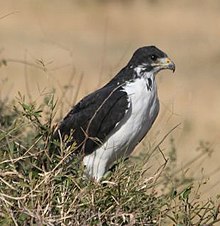
Family: Accipitridae
Accipitridae is a family of birds of prey which includes hawks, eagles, kites, harriers, and Old World vultures. These birds have powerful hooked beaks for tearing flesh from their prey, strong legs, powerful talons, and keen eyesight.
- Black-winged kite, Elanus caeruleus
- African harrier-hawk, Polyboroides typus
- Palm-nut vulture, Gypohierax angolensis (V)
- Egyptian vulture, Neophron percnopterus (V)
- European honey-buzzard, Pernis apivorus
- African cuckoo-hawk, Aviceda cuculoides
- White-headed vulture, Trigonoceps occipitalis
- Lappet-faced vulture, Torgos tracheliotos
- Hooded vulture, Necrosyrtes monachus
- White-backed vulture, Gyps africanus
- Cape griffon, Gyps coprotheres
- Bateleur, Terathopius ecaudatus
- Black-chested snake-eagle, Circaetus pectoralis
- Brown snake-eagle, Circaetus cinereus
- Banded snake-eagle, Circaetus cinerascens
- Bat hawk, Macheiramphus alcinus
- Crowned eagle, Stephanoaetus coronatus (V)
- Martial eagle, Polemaetus bellicosus
- Long-crested eagle, Lophaetus occipitalis
- Lesser spotted eagle, Clanga pomarina
- Wahlberg's eagle, Hieraaetus wahlbergi
- Booted eagle, Hieraaetus pennatus
- Ayres's hawk-eagle, Hieraaetus ayresii
- Tawny eagle, Aquila rapax
- Steppe eagle, Aquila nipalensis
- Verreaux's eagle, Aquila verreauxii
- African hawk-eagle, Aquila spilogaster
- Lizard buzzard, Kaupifalco monogrammicus
- Dark chanting-goshawk, Melierax metabates
- Pale chanting-goshawk, Melierax canorus
- Gabar goshawk, Micronisus gabar
- Eurasian marsh-harrier, Circus aeruginosus (V)
- African marsh-harrier, Circus ranivorus
- Black harrier, Circus maurus
- Pallid harrier, Circus macrourus
- Montagu's harrier, Circus pygargus
- African goshawk, Accipiter tachiro
- Shikra, Accipiter badius
- Little sparrowhawk, Accipiter minullus
- Ovambo sparrowhawk, Accipiter ovampensis
- Black goshawk, Accipiter melanoleucus
- Black kite, Milvus migrans
- African fish-eagle, Haliaeetus vocifer
- Common buzzard, Buteo buteo
- Long-legged buzzard, Buteo rufinus (V)
- Red-necked buzzard, Buteo auguralis (V)
- Augur buzzard, Buteo augur
- Jackal buzzard, Buteo rufofuscus
Order: Strigiformes
Barn-owls
Family: Tytonidae
Barn-owls are medium to large owls with large heads and characteristic heart-shaped faces. They have long strong legs with powerful talons.
- Barn owl, Tyto alba
Owls
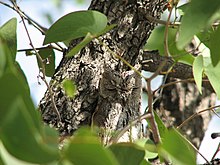
Family: Strigidae
The typical owls are small to large solitary nocturnal birds of prey. They have large forward-facing eyes and ears, a hawk-like beak, and a conspicuous circle of feathers around each eye called a facial disk.
- African scops-owl, Otus senegalensis
- Southern white-faced owl, Ptilopsis granti
- Cape eagle-owl, Bubo capensis
- Spotted eagle-owl, Bubo africanus
- Verreaux's eagle-owl, Bubo lacteus
- Pel's fishing-owl, Scotopelia peli
- Pearl-spotted owlet, Glaucidium perlatum
- African barred owlet, Glaucidium capense
- African wood-owl, Strix woodfordii
- Marsh owl, Asio capensis
Order: Coliiformes
Common name: Mousebirds Family: Coliidae
The mousebirds are slender greyish or brown birds with soft, hairlike body feathers and very long thin tails. They are arboreal and scurry through the leaves like rodents in search of berries, fruit and buds. They are acrobatic and can feed upside down. All species have strong claws and reversible outer toes. They also have crests and stubby bills.
- White-backed mousebird, Colius colius
- Red-faced mousebird, Urocolius indicus
Order: Trogoniformes
Common name: Trogons Family: Trogonidae
The family Trogonidae includes trogons and quetzals. Found in tropical woodlands worldwide, they feed on insects and fruit, and their broad bills and weak legs reflect their diet and arboreal habits. Although their flight is fast, they are reluctant to fly any distance. Trogons have soft, often colourful, feathers with distinctive male and female plumage.
- Narina trogon, Apaloderma narina
Order: Coraciiformes
Kingfishers

Family: Alcedinidae
Kingfishers are medium-sized birds with large heads, long pointed bills, short legs, and stubby tails.
- Half-collared kingfisher, Alcedo semitorquata
- Malachite kingfisher, Corythornis cristatus
- African pygmy kingfisher, Ispidina picta
- Gray-headed kingfisher, Halcyon leucocephala
- Woodland kingfisher, Halcyon senegalensis
- Brown-hooded kingfisher, Halcyon albiventris
- Striped kingfisher, Halcyon chelicuti
- Giant kingfisher, Megaceryle maximus
- Pied kingfisher, Ceryle rudis
Bee-eaters
Family: Meropidae
The bee-eaters are a group of near passerine birds; most species are found in Africa but others occur in southern Europe, Madagascar, Australia, and New Guinea. They are characterised by richly coloured plumage, slender bodies, and usually elongated central tail feathers. They have long downturned bills and pointed wings, which give them a swallow-like appearance when seen from afar.
- White-fronted bee-eater, Merops bullockoides
Northern carmine bee-eater, - Little bee-eater, Merops pusillus
- Swallow-tailed bee-eater, Merops hirundineus
- Blue-cheeked bee-eater, Merops persicus
- Madagascar bee-eater, Merops superciliosus
- European bee-eater, Merops apiaster
- Northern carmine bee-eater, Merops nubicus (V)
- Southern carmine bee-eater, Merops nubicoides
Rollers
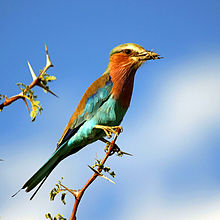
Family: Coraciidae
Rollers resemble crows in size and build, but are more closely related to the kingfishers and bee-eaters. They share the colourful appearance of those groups with blues and browns predominating. The two inner front toes are connected, but the outer toe is not.
- European roller, Coracias garrulus
- Lilac-breasted roller, Coracias caudata
- Racket-tailed roller, Coracias spatulata
- Rufous-crowned roller, Coracias naevia
- Broad-billed roller, Eurystomus glaucurus
Order: Bucerotiformes
Hoopoes
Family: Upupidae
Hoopoes have black, white, and orangey-pink colouring with a large erectile crest on their head.
- African hoopoe, Upupa africana
Woodhoopoes and scimitarbills
Family: Phoeniculidae
The woodhoopoes are related to the hoopoes, hornbills, and ground-hornbills. They most resemble the hoopoes with their long curved bills, used to probe for insects, and short rounded wings. However, they differ in that they have metallic plumage, often blue, green, or purple, and lack an erectile crest.
 |
- Green woodhoopoe, Phoeniculus purpureus
- Violet woodhoopoe, Phoeniculus damarensis
- Common scimitarbill, Rhinopomastus cyanomelas
Ground Hornbills
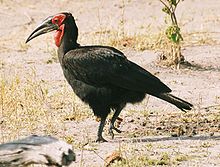
Family: Bucorvidae
The ground-hornbills are terrestrial birds which feed almost entirely on insects, other birds, snakes, and amphibians.
- Southern ground-hornbill, Bucorvus leadbeateri
Hornbills
Family: Bucerotidae
Hornbills are a group of birds whose bill is shaped like a cow's horn, but without a twist, sometimes with a casque on the upper mandible. Frequently, the bill is brightly coloured.
- Crowned hornbill, Lophoceros alboterminatus
Southern yellow-billed hornbill, - Bradfield's hornbill, Lophoceros bradfieldi
- African gray hornbill, Lophoceros nasutus
- Southern yellow-billed hornbill, Tockus leucomelas
- Monteiro's hornbill, Tockus monteiri
- Southern red-billed hornbill, Tockus rufirostris
- Damara red-billed hornbill, Tockus damarensis
Damara red-billed hornbill - Trumpeter hornbill, Bycanistes bucinator
Order: Piciformes
African barbets
Family: Lybiidae
The barbets are plump birds, with short necks and large heads. They get their name from the bristles which fringe their heavy bills. Most species are brightly coloured.
 |
| Yellow-fronted tinkerbird |
- Crested barbet, Trachyphonus vaillantii
- Yellow-fronted tinkerbird, Pogoniulus chrysoconus
- Pied barbet, Tricholaema leucomelas
Pied barbet - Black-collared barbet, Lybius torquatus
Honeyguides
Family: Indicatoridae
Honeyguides are among the few birds that feed on wax. They are named for the greater honeyguide which leads traditional honey-hunters to bees' nests and, after the hunters have harvested the honey, feeds on the remaining contents of the hive.
- Green-backed honeyguide, Prodotiscus zambesiae
- Wahlberg's honeyguide, Prodotiscus regulus
- Lesser honeyguide, Indicator minor
- Greater honeyguide, Indicator indicator
Woodpeckers
Family: Picidae
Woodpeckers are small to medium-sized birds with chisel-like beaks, short legs, stiff tails, and long tongues used for capturing insects. Some species have feet with two toes pointing forward and two backward, while several species have only three toes. Many woodpeckers have the habit of tapping noisily on tree trunks with their beaks.
- Cardinal woodpecker, Chloropicus fuscescens
- Bearded woodpecker, Chloropicus namaquus
- Olive woodpecker, Chloropicus griseocephalus
- Bennett's woodpecker, Campethera bennettii
- Golden-tailed woodpecker, Campethera abingoni
Order: Falconiformes

Common name: Falcons and caracaras Family: Falconidae
Falconidae is a family of diurnal birds of prey. They differ from hawks, eagles, and kites in that they kill with their beaks instead of their talons.
- Pygmy falcon, Polihierax semitorquatus
- Lesser kestrel, Falco naumanni
- Rock kestrel, Falco rupicolus
- Greater kestrel, Falco rupicoloides
- Gray kestrel, Falco ardosiaceus
- Dickinson's kestrel, Falco dickinsoni
- Red-necked falcon, Falco chicquera
- Red-footed falcon, Falco vespertinus
- Amur falcon, Falco amurensis
- Eleonora's falcon, Falco eleonorae (V)
- Sooty falcon, Falco concolor (V)
- Eurasian hobby, Falco subbuteo
- African hobby, Falco cuvierii
- Lanner falcon, Falco biarmicus
- Peregrine falcon, Falco peregrinus
Order: Psittaciformes
Old World parrots

Family: Psittaculidae
Characteristic features of parrots include a strong curved bill, an upright stance, strong legs, and clawed zygodactyl feet. Many parrots are vividly coloured, and some are multi-coloured. In size they range from 8 cm (3.1 in) to 1 m (3.3 ft) in length. Old World parrots are found from Africa east across south and southeast Asia and Oceania to Australia and New Zealand.
- Rosy-faced lovebird, Agapornis roseicollis
- Black-cheeked lovebird, Agapornis nigrigenis
African and New World parrots
Family: Psittacidae
Parrots are small to large birds with a characteristic curved beak. Their upper mandibles have slight mobility in the joint with the skull and they have a generally erect stance. All parrots are zygodactyl, having the four toes on each foot placed two at the front and two to the back. Most of the more than 150 species in this family are found in the New World.
- Brown-necked parrot, Poicephalus fuscicollis
- Meyer's parrot, Poicephalus meyeri
- Rüppell's parrot, Poicephalus rueppellii
Order: Passeriformes
African and green broadbills
Family: Eurylaimidae
The broadbills are small, brightly coloured birds which feed on fruit and also take insects in flycatcher fashion, snapping their broad bills. Their habitat is canopies of wet forests.
- African broadbill, Smithornis capensis
Pittas
Family: Pittidae
Pittas are medium-sized by passerine standards and are stocky, with fairly long, strong legs, short tails, and stout bills. Many are brightly coloured. They spend the majority of their time on wet forest floors, eating snails, insects, and similar invertebrates.
- African pitta, Pitta angolensis (V)
Cuckooshrikes
Family: Campephagidae
The cuckooshrikes are small to medium-sized passerine birds. They are predominantly greyish with white and black, although some species are brightly coloured.
- White-breasted cuckooshrike, Coracina pectoralis
- Black cuckooshrike, Campephaga flava
Old World orioles
Family: Oriolidae
The Old World orioles are colourful passerine birds which are not related to the similar-appearing New World orioles.
- Eurasian golden oriole, Oriolus oriolus
- African golden oriole, Oriolus auratus
- African black-headed oriole, Oriolus larvatus
Wattle-eyes and batises
Family: Platysteiridae
The wattle-eyes, or puffback flycatchers, are small stout passerine birds of the African tropics. They get their name from the brightly coloured fleshy eye decorations found in most species in this group.
- White-tailed shrike, Lanioturdus torquatus
White-tailed shrike, - Chinspot batis, Batis molitor
- Pririt batis, Batis pririt
Vangas, helmetshrikes, and allies
Family: Vangidae
The helmetshrikes are similar in build to the shrikes, but tend to be colourful species with distinctive crests or other head ornaments, such as wattles, from which they get their name.
- White helmetshrike, Prionops plumatus
- Retz's helmetshrike, Prionops retzii
Bushshrikes and allies
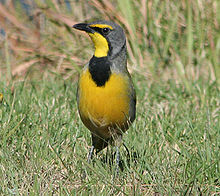
Family: Malaconotidae
Bushshrikes are similar in habits to shrikes, hunting insects and other small prey from a perch on a bush. Although similar in build to the shrikes, these tend to be either colourful species or largely black; some species are quite secretive.
- Black-backed puffback, Dryoscopus cubla
- Brubru, Nilaus afer
- Black-crowned tchagra, Tchagra senegala
- Brown-crowned tchagra, Tchagra australis
- Tropical boubou, Laniarius major
- Gabon boubou, Laniarius bicolor
- Crimson-breasted gonolek, Laniarius atrococcineus
Sulphur-breasted bushshrike - Bokmakierie, Telophorus zeylonus
- Sulphur-breasted bushshrike, Telophorus sulfureopectus
- Gray-headed bushshrike, Malaconotus blanchoti
Drongos

Family: Dicruridae
The drongos are mostly black or dark grey in colour, sometimes with metallic tints. They have long forked tails, and some Asian species have elaborate tail decorations. They have short legs and sit very upright when perched, like a shrike. They flycatch or take prey from the ground.
- Fork-tailed drongo, Dicrurus adsimilis
Monarch flycatchers
Family: Monarchidae
The monarch flycatchers are small to medium-sized insectivorous passerines which hunt by flycatching.
- African paradise-flycatcher, Terpsiphone viridis
African paradise-flycatcher brown morphs
Shrikes

Family: Laniidae
Shrikes are passerine birds known for their habit of catching other birds and small animals and impaling the uneaten portions of their bodies on thorns. A shrike's beak is hooked, like that of a typical bird of prey.
- Red-backed shrike, Lanius collurio
- Lesser gray shrike, Lanius minor
- Magpie shrike, Lanius melanoleucus
- Northern fiscal, Lanius humeralis
- Southern fiscal, Lanius collaris
- Souza's shrike, Lanius souzae
- White-crowned shrike, Eurocephalus anguitimens
Crows, jays, and magpies
Family: Corvidae
The family Corvidae includes crows, ravens, jays, choughs, magpies, treepies, nutcrackers, and ground jays. Corvids are above average in size among the Passeriformes, and some of the larger species show high levels of intelligence.
- House crow, Corvus splendens (V)
- Cape crow, Corvus capensis
- Pied crow, Corvus albus
Fairy flycatchers
Family: Stenostiridae
Most of the species of this small family are found in Africa, though a few inhabit tropical Asia. They are not closely related to other birds called "flycatchers".- Fairy flycatcher, Stenostira scita
Tits, chickadees, and titmice
Family: Paridae
The Paridae are mainly small stocky woodland species with short stout bills. Some have crests. They are adaptable birds, with a mixed diet including seeds and insects.
- Rufous-bellied tit, Melaniparus rufiventris
- Southern black-tit, Melaniparus niger
- Carp's tit, Melaniparus carpi
- Ashy tit, Melaniparus cinerascens
- Gray tit, Melaniparus afer
Penduline-tits
Family: Remizidae
The penduline-tits are a group of small passerine birds related to the true tits. They are insectivores.
- African penduline-tit, Anthoscopus caroli
- Southern penduline-tit, Anthoscopus minutus
Larks

Family: Alaudidae
Larks are small terrestrial birds with often extravagant songs and display flights. Most larks are fairly dull in appearance. Their food is insects and seeds.
- Spike-heeled lark, Chersomanes albofasciata
- Gray's lark, Ammomanopsis grayi
- Karoo long-billed lark, Certhilauda subcoronata
- Cape lark, Certhilauda curvirostris
- Dusky lark, Pinarocorys nigricans
- Black-eared sparrow-lark, Eremopterix australis
- Chestnut-backed sparrow-lark, Eremopterix leucotis
- Gray-backed sparrow-lark, Eremopterix verticalis
- Sabota lark, Calendulauda sabota
- Fawn-colored lark, Calendulauda africanoides
- Red lark, Calendulauda burra
- Barlow's lark, Calendulauda barlowi
- Dune lark, Calendulauda erythrochlamys (E)
- Cape clapper lark, Mirafra apiata
- Eastern clapper lark, Mirafra fasciolata
- Rufous-naped lark, Mirafra africana
- Flappet lark, Mirafra rufocinnamomea
- Monotonous lark, Mirafra passerina
- Red-capped lark, Calandrella cinerea
- Stark's lark, Spizocorys starki
- Sclater's lark, Spizocorys sclateri
- Pink-billed lark, Spizocorys conirostris
- Large-billed lark, Galerida magnirostris
Nicators
Family: Nicatoridae
The nicators are shrike-like, with hooked bills. They are endemic to sub-Saharan Africa.
- Eastern nicator, Nicator gularis
African warblers
Family: Macrosphenidae
African warblers are small to medium-sized insectivores which are found in a wide variety of habitats south of the Sahara.
- Red-faced crombec, Sylvietta whytii (V)
- Cape crombec, Sylvietta rufescens
- Rockrunner, Achaetops pycnopygius
Cisticolas and allies

Family: Cisticolidae
The Cisticolidae are warblers found mainly in warmer southern regions of the Old World. They are generally very small birds of drab brown or grey appearance found in open country such as grassland or scrub.
- Yellow-bellied eremomela, Eremomela icteropygialis
- Greencap eremomela, Eremomela scotops
- Yellow-rumped eremomela, Eremomela gregalis
- Burnt-neck eremomela, Eremomela usticollis
- Namaqua warbler, Phragmacia substriata
- Stierling's wren-warbler, Calamonastes stierlingi
- Barred wren-warbler, Calamonastes fasciolatus
- Green-backed camaroptera, Camaroptera brachyura
- Yellow-breasted apalis, Apalis flavida
- Tawny-flanked prinia, Prinia subflava
- Black-chested prinia, Prinia flavicans
- Karoo prinia, Prinia maculosa
- Kopje warbler, Euryptila subcinnamomea
- Rufous-eared warbler, Malcorus pectoralis
- Red-faced cisticola, Cisticola erythrops
- Rattling cisticola, Cisticola chiniana
- Tinkling cisticola, Cisticola rufilatus
- Red-headed cisticola, Cisticola subruficapillus
- Luapula cisticola, Cisticola luapula
- Chirping cisticola, Cisticola pipiens
- Levaillant's cisticola, Cisticola tinniens
- Piping cisticola, Cisticola fulvicapillus
- Zitting cisticola, Cisticola juncidis
- Desert cisticola, Cisticola aridulus
Reed warblers and allies

Family: Acrocephalidae
The members of this family are usually rather large for "warblers". Most are rather plain olivaceous brown above with much yellow to beige below. They are usually found in open woodland, reedbeds, or tall grass. The family occurs mostly in southern to western Eurasia and surroundings, but it also ranges far into the Pacific, with some species in Africa.
- Olive-tree warbler, Hippolais olivetorum (V)
- Icterine warbler, Hippolais icterina
- Sedge warbler, Acrocephalus schoenobaenus
- Marsh warbler, Acrocephalus palustris
- Common reed warbler, Acrocephalus scirpaceus
- Lesser swamp warbler, Acrocephalus gracilirostris
- Greater swamp warbler, Acrocephalus rufescens
- Great reed warbler, Acrocephalus arundinaceus
Grassbirds and allies
Family: Locustellidae
Locustellidae are a family of small insectivorous songbirds found mainly in Eurasia, Africa, and the Australian region. They are smallish birds with tails that are usually long and pointed, and tend to be drab brownish or buffy all over.
- River warbler, Locustella fluviatilis
- Little rush warbler, Bradypterus baboecala
Swallows

Family: Hirundinidae
The family Hirundinidae is adapted to aerial feeding. They have a slender streamlined body, long pointed wings, and a short bill with a wide gape. The feet are adapted to perching rather than walking, and the front toes are partially joined at the base.
- Plain martin, Riparia paludicola
- Bank swallow, Riparia riparia
- Banded martin, Neophedina cincta
- Rock martin, Ptyonoprogne fuligula
- Barn swallow, Hirundo rustica
- Angola swallow, Hirundo angolensis (V)
- White-throated swallow, Hirundo albigularis
- Wire-tailed swallow, Hirundo smithii
- Pearl-breasted swallow, Hirundo dimidiata
- Greater striped swallow, Cecropis cucullata
- Lesser striped swallow, Cecropis abyssinica
- Rufous-chested swallow, Cecropis semirufa
- Mosque swallow, Cecropis senegalensis
- South African swallow, Petrochelidon spilodera
- Common house-martin, Delichon urbicum
- Gray-rumped swallow, Pseudhirundo griseopyga
Bulbuls
Family: Pycnonotidae
Bulbuls are medium-sized songbirds. Some are colourful with yellow, red, or orange vents, cheeks, throats or supercilia, but most are drab, with uniform olive-brown to black plumage. Some species have distinct crests.
 |
| Yellow-throated greenbul |
- Yellow-bellied greenbul, Chlorocichla flaviventris
- Yellow-throated greenbul, Atimastillas flavicollis (V)
- Terrestrial brownbul, Phyllastrephus terrestris
- Common bulbul, Pycnonotus barbatus
- Black-fronted bulbul, Pycnonotus nigricans
- Cape bulbul, Pycnonotus capensis
Leaf warblers
Family: Phylloscopidae
Leaf warblers are a family of small insectivorous birds found mostly in Eurasia and ranging into Wallacea and Africa. The species are of various sizes, often green-plumaged above and yellow below, or more subdued with greyish-green to greyish-brown colours.
- Willow warbler, Phylloscopus trochilus
Sylviid warblers, parrotbills, and allies
Family: Sylviidae
 |
| Eurasian blackcap |
- Eurasian blackcap, Sylvia atricapilla (V)
- Garden warbler, Sylvia borin
- Layard's warbler, Curruca layardi
- Chestnut-vented warbler, Curruca subcoerulea
- Greater whitethroat, Curruca communis
White-eyes, yuhinas, and allies
Family: Zosteropidae
The white-eyes are small and mostly undistinguished, their plumage above being generally some dull colour like greenish-olive, but some species have a white or bright yellow throat, breast or lower parts, and several have buff flanks. As their name suggests, many species have a white ring around each eye.
- Orange River white-eye, Zosterops pallidus
- Southern yellow white-eye, Zosterops anderssoni
Laughingthrushes and allies
Family: Leiothrichidae
The members of this family are diverse in size and colouration, though those of genus Turdoides tend to be brown or greyish. The family is found in Africa, India, and southeast Asia.
- Arrow-marked babbler, Turdoides jardineii
- Bare-cheeked babbler, Turdoides gymnogenys
- Southern pied-babbler, Turdoides bicolor
- Hartlaub's babbler, Turdoides hartlaubii
- Black-faced babbler, Turdoides melanops
Oxpeckers
Family: Buphagidae
As both the English and scientific names of these birds imply, they feed on ectoparasites, primarily ticks, found on large mammals.
- Red-billed oxpecker, Buphagus erythrorynchus
- Yellow-billed oxpecker, Buphagus africanus
Starlings
Family: Sturnidae
Starlings are small to medium-sized passerine birds. Their flight is strong and direct and they are very gregarious. Their preferred habitat is fairly open country. They eat insects and fruit. Plumage is typically dark with a metallic sheen.
- European starling, Sturnus vulgaris (I)
- Wattled starling, Creatophora cinerea
- Common myna, Acridotheres tristis (V)
- Violet-backed starling, Cinnyricinclus leucogaster
- Pale-winged starling, Onychognathus nabouroup
- Burchell's starling, Lamprotornis australis
- Meves's starling, Lamprotornis mevesii
- Lesser blue-eared starling, Lamprotornis chloropterus
- Sharp-tailed starling, Lamprotornis acuticaudus
- Greater blue-eared starling, Lamprotornis chalybaeus
- Cape starling, Lamprotornis nitens
Thrushes and allies
Family: Turdidae
The thrushes are a group of passerine birds that occur mainly in the Old World. They are plump, soft plumaged, small to medium-sized insectivores or sometimes omnivores, often feeding on the ground. Many have attractive songs.
- Groundscraper thrush, Turdus litsitsirupa
- Kurrichane thrush, Turdus libonyana
- Karoo thrush, Turdus smithi
Old World flycatchers

Family: Muscicapidae
Old World flycatchers are a large group of small passerine birds native to the Old World. They are mainly small arboreal insectivores. The appearance of these birds is highly varied, but they mostly have weak songs and harsh calls.
- Spotted flycatcher, Muscicapa striata
- Mariqua flycatcher, Bradornis mariquensis
- Pale flycatcher, Agricola pallidus
- Chat flycatcher, Agricola infuscatus
- Gray tit-flycatcher, Fraseria plumbeus
- Ashy flycatcher, Fraseria caerulescens
- Herero chat, Melaenornis herero
- Southern black-flycatcher, Melaenornis pammelaina
- Karoo scrub-robin, Cercotrichas coryphaeus
- Bearded scrub-robin, Cercotrichas quadrivirgata
- Kalahari scrub-robin, Cercotrichas paena
- Red-backed scrub-robin, Cercotrichas leucophrys
- Cape robin-chat, Cossypha caffra
- White-browed robin-chat, Cossypha heuglini
- Red-capped robin-chat, Cossypha natalensis
- Angola cave-chat, Xenocopsychus ansorgei
- Collared palm-thrush, Cichladusa arquata
- Rufous-tailed palm-thrush, Cichladusa ruficauda
- Thrush nightingale, Luscinia luscinia
- Collared flycatcher, Ficedula albicollis (V)
- Short-toed rock-thrush, Monticola brevipes
- Whinchat, Saxicola rubetra (V)
- African stonechat, Saxicola torquatus
- Sickle-winged chat, Emarginata sinuata
- Karoo chat, Emarginata schlegelii
- Tractrac chat, Emarginata tractrac
- Southern anteater-chat, Myrmecocichla formicivora
- Mountain wheatear, Myrmecocichla monticola
- Arnot's chat, Myrmecocichla arnotti
- Northern wheatear, Oenanthe oenanthe (V)
- Capped wheatear, Oenanthe pileata
- Familiar chat, Oenanthe familiaris
Sunbirds and spiderhunters
Family: Nectariniidae
 |
| Shelley's sunbird |
The sunbirds and spiderhunters are very small passerine birds which feed largely on nectar, although they will also take insects, especially when feeding young. Flight is fast and direct on their short wings. Most species can take nectar by hovering like a hummingbird, but usually perch to feed.
- Collared sunbird, Hedydipna collaris
- Amethyst sunbird, Chalcomitra amethystina
- Scarlet-chested sunbird, Chalcomitra senegalensis
- Malachite sunbird, Nectarinia famosa
- Southern double-collared sunbird, Cinnyris chalybeus
Variable sunbird, - Mariqua sunbird, Cinnyris mariquensis
- Shelley's sunbird, Cinnyris shelleyi (V)
- Purple-banded sunbird, Cinnyris bifasciatus
- White-breasted sunbird, Cinnyris talatala
- Variable sunbird, Cinnyris venustus (V)
- Dusky sunbird, Cinnyris fuscus
- Copper sunbird, Cinnyris cupreus
Weavers and allies

Family: Ploceidae
The weavers are small passerine birds related to the finches. They are seed-eating birds with rounded conical bills. The males of many species are brightly coloured, usually in red or yellow and black, some species show variation in colour only in the breeding season.
 |
| Red-headed quelea, |
- Red-billed buffalo-weaver, Bubalornis niger
- Scaly weaver, Sporopipes squamifrons
- White-browed sparrow-weaver, Plocepasser mahali
- Sociable weaver, Philetairus socius
- Red-headed weaver, Anaplectes rubriceps
- Spectacled weaver, Ploceus ocularis
- Cape weaver, Ploceus capensis
- Holub's golden-weaver, Ploceus xanthops
- Southern brown-throated weaver, Ploceus xanthopterus
- Lesser masked-weaver, Ploceus intermedius
- Southern masked-weaver, Ploceus velatus
- Village weaver, Ploceus cucullatus
- Chestnut weaver, Ploceus rubiginosus
- Cardinal quelea, Quelea cardinalis (V)
- Red-headed quelea, Quelea erythrops (V)
- Red-billed quelea, Quelea quelea
- Southern red bishop, Euplectes orix
- Yellow-crowned bishop, Euplectes afer
- White-winged widowbird, Euplectes albonotatus
- Fan-tailed widowbird, Euplectes axillaris
- Grosbeak weaver, Amblyospiza albifrons
Waxbills and allies

Family: Estrildidae
The estrildid finches are small passerine birds of the Old World tropics and Australasia. They are gregarious and often colonial seed eaters with short thick but pointed bills. They are all similar in structure and habits, but have wide variation in plumage colours and patterns.
- Bronze mannikin, Spermestes cucullatus
- Magpie mannikin, Spermestes fringilloides (V)
- Black-faced waxbill, Brunhilda erythronotos
- Angola waxbill, Coccopygia bocagei (H)
- Cinderella waxbill, Glaucestrilda thomensis
- Common waxbill, Estrilda astrild
- Quailfinch, Ortygospiza fuscocrissa
- Cut-throat, Amadina fasciata
- Red-headed finch, Amadina erythrocephala
- Zebra waxbill, Amandava subflava
- Violet-eared waxbill, Uraeginthus granatina
- Southern cordonbleu, Uraeginthus angolensis
- Green-winged pytilia, Pytilia melba
- Orange-winged pytilia, Pytilia afra
- Red-billed firefinch, Lagonosticta senegala
- Jameson's firefinch, Lagonosticta rhodopareia
- Brown firefinch, Lagonosticta nitidula
Indigobirds
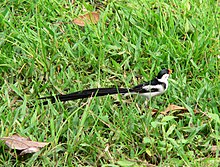
Family: Viduidae
The indigobirds are finch-like species which usually have black or indigo predominating in their plumage. All are brood parasites, which lay their eggs in the nests of estrildid finches.
- Pin-tailed whydah, Vidua macroura
- Broad-tailed paradise-whydah, Vidua obtusa
- Eastern paradise-whydah, Vidua paradisaea
- Shaft-tailed whydah, Vidua regia
- Village indigobird, Vidua chalybeata
- Purple indigobird, Vidua purpurascens
- Parasitic weaver, Anomalospiza imberbis
Old World sparrows
Family: Passeridae
Sparrows are small passerine birds. In general, sparrows tend to be small, plump, brown or grey birds with short tails and short powerful beaks. Sparrows are seed eaters, but they also consume small insects.
- House sparrow, Passer domesticus (I)
- Great rufous sparrow, Passer motitensis
- Cape sparrow, Passer melanurus
- Northern gray-headed sparrow, Passer griseus
- Southern gray-headed sparrow, Passer diffusus
- Yellow-throated bush sparrow, Gymnoris superciliaris
Wagtails and pipits

Family: Motacillidae
Motacillidae is a family of small passerine birds with medium to long tails. They include the wagtails, longclaws, and pipits. They are slender ground-feeding insectivores of open country.
- Cape wagtail, Motacilla capensis
- Gray wagtail, Motacilla cinerea (V)
- Western yellow wagtail, Motacilla flava (V)
- Citrine wagtail, Motacilla citreola (V)
- African pied wagtail, Motacilla aguimp
- African pipit, Anthus cinnamomeus
- Woodland pipit, Anthus nyassae
- Nicholson's pipit, Anthus nicholsoni
- Plain-backed pipit, Anthus leucophrys
- Buffy pipit, Anthus vaalensis
- Tree pipit, Anthus trivialis (V)
- Red-throated pipit, Anthus cervinus (V)
- Rosy-throated longclaw, Macronyx ameliae
Finches, euphonias, and allies

Family: Fringillidae
Finches are seed-eating passerine birds, that are small to moderately large and have a strong beak, usually conical and in some species very large. All have twelve tail feathers and nine primaries. These birds have a bouncing flight with alternating bouts of flapping and gliding on closed wings, and most sing well.
- Yellow-fronted canary, Crithagra mozambicus
- Black-throated canary, Crithagra atrogularis
- Yellow canary, Crithagra flaviventris
- White-throated canary, Crithagra albogularis
- Black-headed canary, Serinus alario
Old World buntings
Family: Emberizidae
The emberizids are a large family of passerine birds. They are seed-eating birds with distinctively shaped bills. In Europe, most species are called buntings. Many emberizid species have distinctive head patterns.
- Ortolan bunting, Emberiza hortulana (V)
- Golden-breasted bunting, Emberiza flaviventris
- Cape bunting, Emberiza capensis
- Lark-like bunting, Emberiza impetuani
- Cinnamon-breasted bunting, Emberiza tahapisi
References
- ^ Clements, J. F., T. S. Schulenberg, M. J. Iliff, S. M. Billerman, T. A. Fredericks, B. L. Sullivan, and C. L. Wood. 2022. The eBird/Clements Checklist of Birds of the World: v2022. Downloaded from https://www.birds.cornell.edu/clementschecklist/updateindex/october-2022/ Retrieved November 1, 2022.
- Lepage, Denis. "Checklist of Birds of Namibia". Bird Checklists of the World. Avibase. Retrieved 27 September 2021.
- Clements, James F. (2007). Birds of the World: A Checklist, 6th edition. Cornell University Press.










